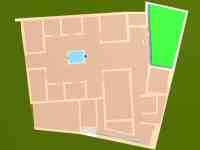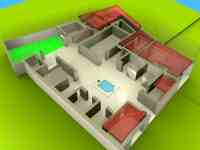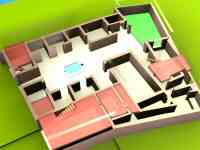
Figure 52: Making the roof largely transparent illustrates the link between the hypothesised roofing configuration and excavated water handling features.
In treating the House of the Surgeon as a discrete site despite its relationship to the insula as a whole, the modelling risks inaccuracy, particularly with respect to the roofing scheme. With properties to both the north and south, the owners of the House of the Surgeon will not have been able to plan their roofing scheme in isolation from their neighbours. The boundary to the north is likely to present few problems; a more or less straight division exists between the House of the Surgeon and the House of the Vestals. The south is more problematic, especially as there is an uncertain relationship between the House of the Surgeon and the unit to the south-west (rooms 3 and 4). The roofing of the house becomes easier if, as in model Surgeon-ac, this unit is treated as an integral part of the property. The interpretation of neighbouring roofing schemes relies on future work to be done on these properties. Once their evidence is incorporated into a view of the whole insula it can be expected to alter thinking on these issues.
The models created to illustrate the upper floor and roof demonstrate that illumination realism is not necessarily important for effectively conveying this information. The lighting was chosen in order to best illustrate the model with no attempt at realism. Colours are also chosen to emphasise the areas with upper floors rather than to reflect the likely appearance of the floors themselves. The shading used for both specular and diffuse light gives a very clean result, ideal for this purpose compared with other more natural methods available in Blender. The removal of specular light altogether, as in Figure 52, gives an even cleaner appearance.

Figure 52: Making the roof largely transparent illustrates the link between the hypothesised roofing configuration and excavated water handling features.
The modelling of the house's earlier phase not only allows a clear communication of the layout but also helps us to be more certain of parts of the later roofing scheme. It demonstrates that the area around the atrium feeding into the impluvium could plausibly have stayed substantially unchanged through to the final phase. The creation of these models also highlights the close relationship between roofing schemes and water capture. It also forces the researcher to examine the issues involved with abutting properties of irregular shape that are possibly owned by different people. The wall between the House of the Vestals and the House of the Surgeon stays largely fixed throughout the properties' lifespans (Jones and Robinson 2004). The boundary to the south of the house is less certain, with the hypothesised early colonnade phase having a slightly different alignment to the Augustan remodelling.
The models' capacity to display hypotheses more or less instantly proved itself to be very useful during the course of the field season. One pleasing, but unexpected, aspect was the ability to come down fairly firmly on one hypothesis at the expense of the others. Taken in conjunction with the new evidence and ideas discovered in the 2006 field season, Surgeon-ac (Figure 44) seems a more plausible attempt at reconstruction than the other two models (Figures 42 and 43). It also happens to be the simplest in practical terms, with less need for separate small roofs over individual upper storeys. In this respect the presence of the other two models at least conveys the idea that there may be other hypotheses available that are worth considering, even if they too are less plausible than the one formulated towards the end of the excavation project.
Figures 53 and 54 show the extents of the upper floors in the Surgeon-aa and Surgeon-ab models, Surgeon-ac having the same upper floor configuration as Surgeon-ab but with a different roofing scheme. As can be seen, the differing heights of the beam sockets in room 15 and the corridor south of room 8A necessitates a step in the upper floor in Surgeon-aa. These models are rendered with all walls above 2.15m made largely transparent. This enables the upper floors to be illustrated clearly in all three dimensions.

Figure 53: Surgeon-aa from the north-west

Figure 54: Surgeon-ab from the south-west
Using this method of illustration not only gives the archaeologist a much clearer way of displaying three-dimensional data but also serves as a valuable interpretational tool. The creation of this model led to the creation of Surgeon-ad in order to understand roofing issues more clearly. It also served as the basic template for all the other models. Once the initial model is complete it can be customised in any manner required for any other role. It was an unexpected result of this research that this model functioned well as an interpretive and visualisation tool with surprisingly little detail. Even the addition of windows was deemed unnecessary in these models. The decision to take a slice through the walls at a certain height not only rendered the upper floors more visible but also gave a valuable sense of scale, both relatively between different areas and absolutely.
© Internet Archaeology/Author(s)
URL: http://intarch.ac.uk/journal/issue23/3/resarch.html
Last updated: Tues Feb 5 2008